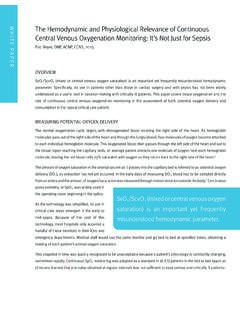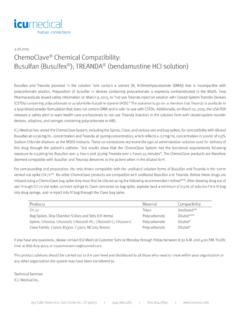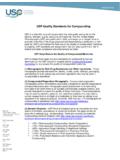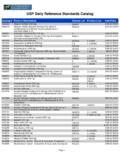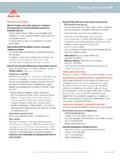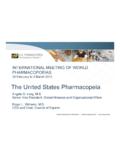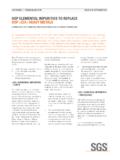Transcription of Cost-Effective Implementation of Closed System Transfer ...
1 WHITE PAPERCost- effective Implementation of Closed System Transfer Devices (CSTDs) to Comply with USP General Chapter <800> INTRODUCTIONA wareness of the dangers of exposure to hazardous drugs (HDs) used in healthcare has increased dramatically in recent years. As this understanding has evolved, so has industry regulation calling for use of environmental controls to help keep patients and healthcare workers safe. One organization active in the guidance of safe drug handling practices in the United States is the Pharmacopeial Convention (USP), which maintains a comprehensive set of drug handling standards enforceable by the United States Food and Drug Administration (FDA) and referenced in over 140 countries around the the most recent update to its comprehensive standards, USP s proposed Chapter <800> (USP <800>) will for the first time require facilities to utilize CSTDs during administration to patients, while encouraging compounding facilities to utilize CSTDs during hazardous drug preparation.
2 While the comprehensive USP <800> safe handling guidelines will have significant budgetary implications for healthcare facilities, implementing CSTDs can be one of the most Cost-Effective ways to start improving safety and health System pharmacy leaders recognize the mounting evidence supporting the use of CSTDs, they have struggled to accept the relatively high cost of Implementation . As a result, the adoption of CSTDs in US hospitals has grown slowly, reaching only 41% in Of the hospitals yet to implement, nearly 80% cited cost as a main barrier, pointing to the imminent need for facilities to identify Cost-Effective solutions to keep them both safe and in compliance with USP <800>.Of the handful of CSTDs on the market, ICU Medical's ChemoClave and ChemoLock CSTD systems offer a variety of Cost-Effective USP <800> compliant solutions. One study showed that ChemoClave, in particular, was the most Cost-Effective CSTD solution for facilities to With availability of both manual and automated CSTD compounding technology, ICU Medical CSTD technology can help facilities cost -effectively adhere to USP <800> guidelines, regardless of preparation volumes and s proposed Chapter <800> will for the first time require facilities to utilize CSTDs during administration to patients, while encouraging compounding facilities to utilize CSTDs during hazardous drug ICU Medical CSTDs for HD compounding can help minimize costs by allowing you to:1.
3 Implement the lowest cost CSTD2. Utilize multi-packs and specialty kits for volume-based savings3. Minimize costs with automated compounding technologyAdministrationUsing ICU Medical CSTDs for HD administration can help minimize costs by allowing you to:1. Avoid replacing administration sets for patients receiving multiple drugs per treatment2. Avoid additional components required for nursingUSP CHAPTER <800> SPOTLIGHT ON CSTDSUSP General Chapter <800> Hazardous Drugs Handling in Healthcare Settings in the Pharmacopeial Forum (PF) proposes new standards to protect personnel and the environment when handling HDs. These standards highlight the role of CSTDs throughout the HD handling process, from drug compounding in the pharmacy to transportation and administration to patients. This new direction regarding CSTD use is stronger than that found in the preceding Chapter <797>. While the older guidelines state that CSTD use is preferred the proposed Chapter <800> guidance states that CSTDs should be used when compounding HDs when the dosage form allows and that CSTDs must be used when administering HDs when the dosage form allows.
4 Section 11 of USP <800> adds that each facility must establish standard operating procedures (SOPs) for the labeling, handling, packaging, and transport of HDs that address the, prevention of accidental exposures or spills, personnel training on response to exposure, and use of a spill kit. 4 Among the exposure-reducing strategies listed, USP <800> specifies the use of CSTDs to facilitate safe handling compliance. Minimizing Costs of CSTDs Used in the PharmacyThere are multiple ways in which health System pharmacy leaders can control the cost of implementing CSTDs, but the true financial impact of using the devices is dependent on the volume of daily mixes performed in the pharmacy. For hospitals and cancer centers compounding fewer than 30 HD preparations each day, manual (by hand) CSTD compounding technologies are generally the most Cost-Effective , while high-volume facilities compounding greater than 30 preparations per day can more effectively offset the cost of CSTDs by implementing automated compounding technologies featuring reusable CSTD components.
5 The majority of CSTDs offered by providers including Becton Dickinson and Company (PhaSeal /Texium ), Equashield, LLC (Equashield ), and B Braun (OnGuard ), are limited to manual compounding solutions. While ICU Medical CSTDs are similarly offered as manual systems, they have also been integrated into the Diana automated drug compounding System to enable facilities of all sizes to cost -effectively comply with USP <800> recommendations in the CSTD COSTS FOR LOW-VOLUME COMPOUNDING FACILITIES 1. Implement the Lowest cost CTSDLow-volume pharmacies rely on manual CSTD compounding methods that require single-use CSTD components for each preparation. As a result, the first determinant of CSTD affordability for these facilities is the cost of the devices themselves. A comparison of total annual costs associated with implementing the various CSTDs is illustrated in Figure 1. Component costs may vary slightly due to manufacturing price changes, contract pricing, and/or volume discount pricing, but in most cases, the ChemoClave System , which meets the NIOSH definition of a Closed System , is the lowest cost option for standalone CSTD components in the marketplace today.
6 FIGURE 1: TOTAL ANNUAL COSTS ASSOCIATED WITH IMPLEMENTING COMPETING CSTDS3 Texium /SmartSite ChemoClave $-$500,000$450,000$400,000$350,000$300,0 00 PhaSeal EquaShield OnGuard $250,000 CostComponent cost may vary slightly due to manufacturing price changes, contract pricing, and/or volume discount pricing. Texium/SmartSite is marketed as a Closed System , not a CSTD.$200,000$150,000$100,000$50,000$200 ,281$ 5 0 7, 2 8 7$435,473$393,978$239,020 Manual CSTD Component (1 Per Mix)Automated CSTD Component (Reusable for Each Mix)In some cases, the volume of drug required for an IV push is actually greater than the volume of a single syringe, requiring technicians to use as many as five syringes for a single treatment, each with a disposable CSTD syringe component. In instances where multiple syringes and vial adapters are used for a single preparation, the savings achieved by using lower- cost ChemoClave components will have an even greater impact. MINIMIZING CSTD COSTS FOR HIGH-VOLUME FACILITIES2.
7 Utilize Multi-Packs and Specialty Kits for Volume-Based SavingsFacilities compounding high-volumes of HD each day are especially vulnerable to the costs associated with high supply usage; however, high volume pharmacies can help offset the costs of CSTD Implementation by ordering commonly used items in multi-packs and kits. ChemoClave and ChemoLock CSTD multi-packs provide pharmacies with price discounts on frequently used components, including vial spikes and bag spikes. In addition to multi-pack volume discounts, the ChemoClave and ChemoLock systems allow pharmacies to design specialty kits that include all CSTD components needed for a specific, repeated preparation, all at a cost lower than the sum of the individual components if purchased Minimize Costs with Automated Compounding TechnologyHigh-volume compounding facilities can also minimize CSTD costs by implementing automated compounding technology that integrates reusable CSTD components. Substituting reusable CSTD components for single-use components helps decrease the cost per mix as volumes of preparations of the same medication increase, eventually bringing costs per mix below that of manual, single-use methods (Figure 2).
8 Currently, the only available automated drug compounding System that integrates CSTD technology is the Diana automated drug compounding System . The Diana System uses ChemoClave or ChemoLock CSTD components to minimize exposure to HDs and preserve drug sterility, while offering the clinical accuracy and ergonomic benefits of compounding automation. The ChemoClave System , which meets the NIOSH definition of a Closed System , was shown to cost between $38,739 and $307,006 less to implement than competing cost $ $ 2: MANUAL VS. AUTOMATED COMPOUNDING: CONSUMABLE ANALYSIS USING AN EXAMPLE OF 10 PACLITAXEL 60CC MIXES PER DAYTOTAL cost $ $ Diana System integrates a reusable CSTD component that transfers HD from a vial into a patient IV bag or syringe. As a result, this reusable component replaces the need for single-use syringe adapters that would normally be disposed of after each use, allowing the cost per mix of CSTD disposables to decrease the more times the System is used (Figure 3).
9 With options for acquiring the Diana System at no up-front capital cost , high-volume compounding facilities can comply with USP <800> CSTD recommendations more cost -effectively than with strictly manual CSTD solutions, while gaining the added benefits of compounding automation.$ $ 0$ $ 7. 0 0$ $ $ $ $ $ 00 Price Per Use 2 4 6 8 10 12 14 16 18 EquashieldOnGuardPhaSealChemoLockTexium/ VialShieldDiana with ICU Medical CSTDN umber of UsesFIGURE 3: ECONOMY OF SCALE USING THE DIANA AUTOMATED COMPOUNDING System WITH ICU MEDICAL CSTDs*Using the Diana System for frequent preparations of the same drug can bring the cost per mix below that of strictly manual compounding systems. *Based on estimated component Benefits of Automated Compounding with the Diana System In addition to helping minimize CSTD costs for high-volume compounding facilities, the Diana System can help efforts to improve the accuracy, safety, and efficiency of hazardous drug preparation.
10 User-Controlled Automated Compounding for Maximum Accuracy and SafetyIncreases Efficiencies by Allowing for MultitaskingClosed System Ensures Safety of Clinicians and the Sterility of the Mix Reduces Risk of Repetitive Stress Injuries Minimizing Costs of CSTDs Used in NursingUSP <800> CSTD language is strongest in its guidance for CSTD use during patient administration. This new guidance mandates the use of CSTDs for the safe administration of HDs, stating CSTDs must be used when administering HDs when the dosage form allows. CSTDs used during the administration process take the form of bag spikes, administration sets, and other components that help maintain Closed systems during both IV pump infusion and direct IV push delivery. Mandating the use of these safe handling systems during administration will undoubtedly help improve nursing safety by minimizing the risk of dangerous exposure to HDs, but the added expense may also have a significant budgetary impact.
